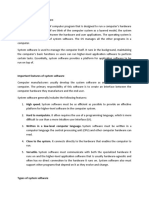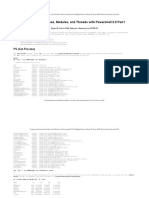0 ratings0% found this document useful (0 votes)
5 viewsComputer Elements
It's a valuable book for IT students. I am sure this pdf will be helpful to students.
Uploaded by
af3592364Copyright
© © All Rights Reserved
Available Formats
Download as PPTX, PDF, TXT or read online on Scribd
0 ratings0% found this document useful (0 votes)
5 viewsComputer Elements
It's a valuable book for IT students. I am sure this pdf will be helpful to students.
Uploaded by
af3592364Copyright
© © All Rights Reserved
Available Formats
Download as PPTX, PDF, TXT or read online on Scribd
You are on page 1/ 39
What is System Software?
• System software is the foundational layer of
software that manages and controls a computer’s
hardware and provides an environment for
running application software. It acts as an
intermediary between hardware and the end-
user, enabling the smooth operation of a
computer system. Unlike application software,
which performs specific tasks for the user, system
software is essential for the overall functioning of
the computer.
Types of System Software
• System software can be categorized into several main types:
• 1. Operating Systems (OS)
• The operating system is the most essential system software. It provides a user
interface, manages hardware resources, and allows applications to run.
Popular operating systems include:
• Windows: Widely used on PCs for personal and business applications.
• MacOS: Apple’s OS for Mac computers, known for its integration with Apple’s
ecosystem.
• Linux: An open-source OS favored for its flexibility, security, and wide use in
servers and programming environments.
• Unix: Used primarily in servers and workstations, especially in academic and
research settings.
• Role of OS:
• Manages memory and storage.
• Controls input/output operations.
• Handles multitasking and scheduling.
• Manages user permissions and security.
2. Device Drivers
• Device drivers are specialized software that enable the OS to
communicate with hardware components, such as printers, graphics
cards, and network adapters. Without drivers, hardware devices
cannot function or communicate with the OS.
• Printer Driver: Allows the computer to communicate with a printer
and control printing tasks.
• Graphics Driver: Manages communication between the OS and the
graphics card, crucial for rendering images and videos.
• Network Driver: Enables network connections, allowing devices to
connect to the internet or other networks.
• Role of Device Drivers:
• Translate OS commands into device-specific commands.
• Enable the OS to detect and use hardware devices automatically.
3. Utility Programs
• Utilities are system software designed to help analyze, configure,
and optimize computer performance. They often provide
maintenance functions to keep the system running smoothly.
• Antivirus Software: Protects against malware, viruses, and other
threats.
• Disk Management Tools: Defragment disks, manage disk partitions,
and free up disk space.
• Backup Software: Helps back up files and systems to prevent data
loss.
• Compression Tools: Compress files to save storage space or
facilitate file transfer (e.g., WinRAR, 7-Zip).
• Role of Utility Programs:
• Enhance security and efficiency.
• Maintain system health by regularly cleaning, optimizing, and
securing the OS and files.
4. Firmware
• Firmware is a specialized form of software that is embedded
directly into hardware components. It provides low-level control
for specific hardware and often includes essential instructions
that allow the hardware to communicate with other system
components.
• BIOS/UEFI: Basic Input/Output System or Unified Extensible
Firmware Interface, which initializes hardware during booting.
• Embedded Firmware: Found in devices like routers, printers, and
IoT devices, enabling them to perform their specific functions.
• Role of Firmware:
• Provides essential instructions for starting up devices.
• Ensures device stability by directly controlling hardware
functions.
• Can be updated to improve functionality or security.
5. Language Translators
• Language translators (also called compilers, assemblers, or
interpreters) convert high-level programming code into
machine language that the computer’s processor can execute.
• Compilers: Translate entire programs from languages like C++
or Java into machine code before execution.
• Interpreters: Translate and execute code line-by-line, typically
used in scripting languages like Python and JavaScript.
• Assemblers: Convert assembly language, a low-level language,
into machine language.
• Role of Language Translators:
• Allow programmers to write code in human-readable
languages.
• Optimize code for efficiency and execution on hardware.
• Enable program portability across different platforms.
Importance of System Software
• Efficient Resource Management: System software
manages the computer's resources, such as memory,
CPU, and storage, ensuring that multiple applications can
run simultaneously without conflict.
• User and Hardware Interaction: It allows users to
interact with the hardware without needing in-depth
knowledge of how the hardware functions.
• Security and Protection: System software often includes
security features, like firewalls and access control, to
protect the computer from unauthorized access and
malware threats.
Conti...
• Optimized Performance: Through tasks like
memory management and process scheduling,
system software optimizes computer performance,
enabling a smooth and fast user experience.
• Platform for Application Software: System
software provides the necessary infrastructure for
running application software, which is essential for
productive use of the computer.
limitation of application
• Application software, while essential for performing
specific tasks on a computer, has several limitations.
These include:
• Dependency on System Software: Application software
relies heavily on system software (like the operating
system) to function. Compatibility issues can arise if the
application is not supported by the system’s OS, which
restricts usability across different systems.
• Limited Scope and Functionality: Application software is
designed for specific tasks (e.g., word processing, photo
editing, accounting) and typically cannot handle tasks
outside its intended purpose. This means users need
multiple applications for different types of tasks, which
can be inefficient.
Conti...
• System Resource Usage: Many application programs
consume a large amount of system resources like CPU,
RAM, and storage. Running multiple applications
simultaneously can slow down system performance,
especially on computers with limited resources.
• Upkeep and Maintenance: Application software often
requires regular updates for new features, security
patches, and bug fixes. Managing these updates can
be time-consuming and may also lead to compatibility
issues with other software or system updates.
Conti...
• Platform Dependency: Some applications are
platform-specific, meaning they are only available
on certain operating systems (e.g., Windows-only
or macOS-only). This restricts users who operate
across multiple platforms or need cross-platform
compatibility.
• These limitations highlight the importance of
carefully selecting, updating, and managing
application software to maximize productivity
while minimizing inefficiencies and risks.
You might also like
- Application Packaging Request Form (Services - File)0% (1)Application Packaging Request Form (Services - File)5 pages
- Immediate download Darshan InstitutE of Technology SEM 5 INDUS UNIVERSITY AHMEDABAD SP CSE Ssssss ebooks 2024100% (4)Immediate download Darshan InstitutE of Technology SEM 5 INDUS UNIVERSITY AHMEDABAD SP CSE Ssssss ebooks 202465 pages
- Applicartion Software and System SoftwareNo ratings yetApplicartion Software and System Software28 pages
- Computer Fundamental - Unit III (Lecture Notes)No ratings yetComputer Fundamental - Unit III (Lecture Notes)5 pages
- UNIT-4 Fundamentals of Information Technology (Question and Answers)No ratings yetUNIT-4 Fundamentals of Information Technology (Question and Answers)17 pages
- Software: Systems and Application SoftwareNo ratings yetSoftware: Systems and Application Software58 pages
- CPT122 - Introduction To Computer Hardware Module 1 Unit 2No ratings yetCPT122 - Introduction To Computer Hardware Module 1 Unit 29 pages
- System Software Is The Type of Software That Is The Interface Between Application Software and SystemNo ratings yetSystem Software Is The Type of Software That Is The Interface Between Application Software and System27 pages
- Instant Download Darshan InstitutE of Technology SEM 5 INDUS UNIVERSITY AHMEDABAD SP CSE Ssssss PDF All Chapters100% (2)Instant Download Darshan InstitutE of Technology SEM 5 INDUS UNIVERSITY AHMEDABAD SP CSE Ssssss PDF All Chapters65 pages
- LSSC Comp. Sc. Chapter 4 System SoftwareNo ratings yetLSSC Comp. Sc. Chapter 4 System Software12 pages
- IBM Tivoli Storage Manager For Databases Data Protection For Oracle For UNIX and Linux Installation and User's Guide Version 5.4.1No ratings yetIBM Tivoli Storage Manager For Databases Data Protection For Oracle For UNIX and Linux Installation and User's Guide Version 5.4.1116 pages
- Enciclopedia Universale Del Bimby Volume 26 PDFNo ratings yetEnciclopedia Universale Del Bimby Volume 26 PDF122 pages
- What Is Power BI - Power BI - Microsoft Docs100% (1)What Is Power BI - Power BI - Microsoft Docs4 pages
- Sylvester Maurus, Aristotelis Opera Omnia, I (Logica, Rhetorica, Poetica), Roma, 1668100% (1)Sylvester Maurus, Aristotelis Opera Omnia, I (Logica, Rhetorica, Poetica), Roma, 1668999 pages
- Introduction To Computer and Programming: Prof. Nilesh Gambhava100% (1)Introduction To Computer and Programming: Prof. Nilesh Gambhava25 pages
- Over The Air Programming Via Radio Manager RM Otap User GuideNo ratings yetOver The Air Programming Via Radio Manager RM Otap User Guide24 pages
- Looking at Processes, Modules, and Threads With Powershell 2.0 Part INo ratings yetLooking at Processes, Modules, and Threads With Powershell 2.0 Part I11 pages
- Sky Deutschland HD 19E - Free Cardsharing TestNo ratings yetSky Deutschland HD 19E - Free Cardsharing Test4 pages
- Speed Up Your Internet Access Using Squid's Refresh PatternsNo ratings yetSpeed Up Your Internet Access Using Squid's Refresh Patterns5 pages
- 07-Fikri Ardiansyah-Xii-Tkj-1 - Application Letter PDFNo ratings yet07-Fikri Ardiansyah-Xii-Tkj-1 - Application Letter PDF1 page
- Maharashtra Pomegranate Exporters PDF - PDF - MumbaiNo ratings yetMaharashtra Pomegranate Exporters PDF - PDF - Mumbai7 pages
- Android - PC Chatting & Image Sharing System: Features100% (1)Android - PC Chatting & Image Sharing System: Features3 pages
- Software Requirements Specification 4 PDFNo ratings yetSoftware Requirements Specification 4 PDF21 pages
- Js 1 Second Term Notes - 240213 - 102941No ratings yetJs 1 Second Term Notes - 240213 - 10294120 pages
- Weekly Diary For Industrial Training at Industry Name: TCSNo ratings yetWeekly Diary For Industrial Training at Industry Name: TCS7 pages
- 62 Menu Bar Apps That Will Take Your Mac To The Next LevelNo ratings yet62 Menu Bar Apps That Will Take Your Mac To The Next Level1 page
- Module 2: Introducing Anypoint Platform: at The End of This Module, You Should Be Able ToNo ratings yetModule 2: Introducing Anypoint Platform: at The End of This Module, You Should Be Able To22 pages
- Application Packaging Request Form (Services - File)Application Packaging Request Form (Services - File)
- Immediate download Darshan InstitutE of Technology SEM 5 INDUS UNIVERSITY AHMEDABAD SP CSE Ssssss ebooks 2024Immediate download Darshan InstitutE of Technology SEM 5 INDUS UNIVERSITY AHMEDABAD SP CSE Ssssss ebooks 2024
- UNIT-4 Fundamentals of Information Technology (Question and Answers)UNIT-4 Fundamentals of Information Technology (Question and Answers)
- CPT122 - Introduction To Computer Hardware Module 1 Unit 2CPT122 - Introduction To Computer Hardware Module 1 Unit 2
- System Software Is The Type of Software That Is The Interface Between Application Software and SystemSystem Software Is The Type of Software That Is The Interface Between Application Software and System
- Instant Download Darshan InstitutE of Technology SEM 5 INDUS UNIVERSITY AHMEDABAD SP CSE Ssssss PDF All ChaptersInstant Download Darshan InstitutE of Technology SEM 5 INDUS UNIVERSITY AHMEDABAD SP CSE Ssssss PDF All Chapters
- Software Design And Development in your pocketFrom EverandSoftware Design And Development in your pocket
- IBM Tivoli Storage Manager For Databases Data Protection For Oracle For UNIX and Linux Installation and User's Guide Version 5.4.1IBM Tivoli Storage Manager For Databases Data Protection For Oracle For UNIX and Linux Installation and User's Guide Version 5.4.1
- Sylvester Maurus, Aristotelis Opera Omnia, I (Logica, Rhetorica, Poetica), Roma, 1668Sylvester Maurus, Aristotelis Opera Omnia, I (Logica, Rhetorica, Poetica), Roma, 1668
- Introduction To Computer and Programming: Prof. Nilesh GambhavaIntroduction To Computer and Programming: Prof. Nilesh Gambhava
- Over The Air Programming Via Radio Manager RM Otap User GuideOver The Air Programming Via Radio Manager RM Otap User Guide
- Looking at Processes, Modules, and Threads With Powershell 2.0 Part ILooking at Processes, Modules, and Threads With Powershell 2.0 Part I
- Speed Up Your Internet Access Using Squid's Refresh PatternsSpeed Up Your Internet Access Using Squid's Refresh Patterns
- 07-Fikri Ardiansyah-Xii-Tkj-1 - Application Letter PDF07-Fikri Ardiansyah-Xii-Tkj-1 - Application Letter PDF
- Maharashtra Pomegranate Exporters PDF - PDF - MumbaiMaharashtra Pomegranate Exporters PDF - PDF - Mumbai
- Android - PC Chatting & Image Sharing System: FeaturesAndroid - PC Chatting & Image Sharing System: Features
- Weekly Diary For Industrial Training at Industry Name: TCSWeekly Diary For Industrial Training at Industry Name: TCS
- 62 Menu Bar Apps That Will Take Your Mac To The Next Level62 Menu Bar Apps That Will Take Your Mac To The Next Level
- Module 2: Introducing Anypoint Platform: at The End of This Module, You Should Be Able ToModule 2: Introducing Anypoint Platform: at The End of This Module, You Should Be Able To

























































































